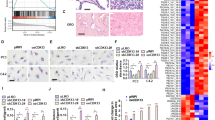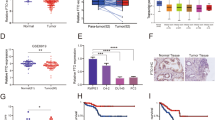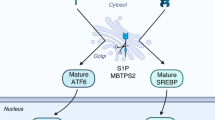Abstract
Cancer cells reprogram their metabolism to maintain both viability and uncontrolled proliferation. Although an interplay between the genetic, epigenetic and metabolic rewiring in cancer is beginning to emerge, it remains unclear how this metabolic plasticity occurs. Here, we report that in prostate cancer cells (PCCs) microRNAs (miRNAs) greatly contribute to deregulation of mitochondrial fatty acid (FA) oxidation via carnitine system modulation. We provide evidence that the downregulation of hsa-miR-124-3p, hsa-miR-129-5p and hsa-miR-378 induced an increase in both expression and activity of CPT1A, CACT and CrAT in malignant prostate cells. Moreover, the analysis of human prostate cancer and prostate control specimens confirmed the aberrant expression of miR-124-3p, miR-129-5p and miR-378 in primary tumors. Forced expression of the miRNAs mentioned above affected tumorigenic properties, such as proliferation, migration and invasion, in PC3 and LNCaP cells regardless of their hormone sensitivity. CPT1A, CACT and CrAT overexpression allow PCCs to be more prone on FA utilization than normal prostate cells, also in the presence of high pyruvate concentration. Finally, the simultaneous increase of CPT1A, CACT and CrAT is fundamental for PCCs to sustain FA oxidation in the presence of heavy lipid load on prostate cancer mitochondria. Indeed, the downregulation of only one of these proteins reduces PCCs metabolic flexibility with the accumulation of FA-intermediate metabolites in the mitochondria. Together, our data implicate carnitine cycle as a primary regulator of adaptive metabolic reprogramming in PCCs and suggest new potential druggable pathways for prevention and treatment of prostate cancer.
This is a preview of subscription content, access via your institution
Access options
Subscribe to this journal
Receive 50 print issues and online access
$259.00 per year
only $5.18 per issue
Buy this article
- Purchase on Springer Link
- Instant access to full article PDF
Prices may be subject to local taxes which are calculated during checkout








Similar content being viewed by others
References
Dang CV, Semenza GL . Oncogenic alterations of metabolism. Trends Biochem Sci 1999; 24: 68–72.
Dang CV . Links between metabolism and cancer. Genes Dev 2012; 26: 877–890.
Modica-Napolitano JS, Singh KK . Mitochondrial dysfunction in cancer. Mitochondrion 2004; 4: 755–762.
DeBerardinis RJ, Mancuso A, Daikhin E, Nissim I, Yudkoff M, Wehrli S et al. Beyond aerobic glycolysis: Transformed cells can engage in glutamine metabolism that exceeds the requirement for protein and nucleotide synthesis. Proc Natl Acad Sci 2007; 104: 19345–19350.
Semenza GL . HIF-1: upstream and downstream of cancer metabolism. Curr Opin Genet Dev 2010; 20: 51–56.
Shanware NP, Mullen AR, DeBerardinis RJ, Abraham RT . Glutamine: pleiotropic roles in tumor growth and stress resistance. J Mol Med (Berl) 2011; 89: 229–236.
DeBerardinis RJ . Is cancer a disease of abnormal cellular metabolism? New angles on an old idea. Genet Med 2008; 10: 767–777.
McDunn JE, Li Z, Adam KP, Neri BP, Wolfert RL, Milburn MV et al. Metabolomic signatures of aggressive prostate cancer. Prostate 2013; 73: 1547–1560.
Sreekumar A, Poisson LM, Rajendiran TM, Khan AP, Cao Q, Yu J et al. Metabolomic profiles delineate potential role for sarcosine in prostate cancer progression. Nature 2009; 457: 910–914.
Teahan O, Bevan CL, Waxman J, Keun HC . Metabolic signatures of malignant progression in prostate epithelial cells. Int J Biochem Cell Biol 2011; 43: 1002–1009.
Costello LC, Franklin RB . The intermediary metabolism of the prostate: a key to understanding the pathogenesis and progression of prostate malignancy. Oncology 2000; 59: 269–282.
Costello LC, Franklin RB . 'Why do tumour cells glycolyse?': from glycolysis through citrate to lipogenesis. Mol Cell Biochem 2005; 280: 1–8.
Liu Y . Fatty acid oxidation is a dominant bioenergetic pathway in prostate cancer. Prostate Cancer Prostatic Dis 2006; 9: 230–234.
Liu Y, Zuckier LS, Ghesani NV . Dominant uptake of fatty acid over glucose by prostate cells: a potential new diagnostic and therapeutic approach. Anticancer Res 2010; 30: 369–374.
Schlaepfer IR, Glode LM, Hitz CA, Pac CT, Boyle KE, Maroni P et al. Inhibition of lipid oxidation increases glucose metabolism and enhances 2-Deoxy-2-[(18)F]Fluoro-D-glucose uptake in prostate cancer mouse xenografts. Mol Imaging Biol 2015; 17: 529–538.
Wu X, Daniels G, Lee P, Monaco ME . Lipid metabolism in prostate cancer. Am J Clin Exp Urol 2014; 2: 111–120.
Bastin J . Regulation of mitochondrial fatty acid beta-oxidation in human: what can we learn from inborn fatty acid beta-oxidation deficiencies? Biochimie 2014; 96: 113–120.
Foster DW . The role of the carnitine system in human metabolism. Ann N Y Acad Sci 2004; 1033: 1–16.
Bonnefont JP, Djouadi F, Prip-Buus C, Gobin S, Munnich A, Bastin J . Carnitine palmitoyltransferases 1 and 2: biochemical, molecular and medical aspects. Mol Aspects Med 2004; 25: 495–520.
Ramsay RR, Gandour RD, van der Leij FR . Molecular enzymology of carnitine transfer and transport. Biochim Biophys Acta 2001; 1546: 21–43.
Jogl G, Hsiao YS, Tong L . Structure and function of carnitine acyltransferases. Ann N Y Acad Sci 2004; 1033: 17–29.
Calin GA, Croce CM . MicroRNA signatures in human cancers. Nat Rev Cancer 2006; 6: 857–866.
Khanmi K, Ignacimuthu S, Paulraj MG . MicroRNA in prostate cancer. Clin Chim Acta 2015; 451: 154–160.
Kurisetty VV, Lakshmanaswamy R, Damodaran C . Pathogenic and therapeutic role of miRNAs in breast cancer. Front Biosci (Landmark Ed) 2014; 19: 1–11.
Liu X, Chen X, Yu X, Tao Y, Bode AM, Dong Z et al. Regulation of microRNAs by epigenetics and their interplay involved in cancer. J Exp Clin Cancer Res 2013; 32: 96.
Price DT, Coleman RE, Liao RP, Robertson CN, Polascik TJ, DeGrado TR . Comparison of [18 F]fluorocholine and [18 F]fluorodeoxyglucose for positron emission tomography of androgen dependent and androgen independent prostate cancer. J Urol 2002; 168: 273–280.
Arora A, Singh S, Bhatt AN, Pandey S, Sandhir R, Dwarakanath BS . Interplay Between Metabolism and Oncogenic Process: Role of microRNAs. Transl Oncogenomics 2015; 7: 11–27.
Pinweha P, Rattanapornsompong K, Charoensawan V, Jitrapakdee S . MicroRNAs and oncogenic transcriptional regulatory networks controlling metabolic reprogramming in cancers. Comput Struct Biotechnol J 2016; 14: 223–233.
Love MI, Huber W, Anders S . Moderated estimation of fold change and dispersion for RNA-seq data with DESeq2. Genome Biol 2014; 15: 550.
Cardenas-Navia LI, Mace D, Richardson RA, Wilson DF, Shan S, Dewhirst MW . The pervasive presence of fluctuating oxygenation in tumors. Cancer Res 2008; 68: 5812–5819.
Ambs S, Prueitt RL, Yi M, Hudson RS, Howe TM, Petrocca F et al. Genomic profiling of microRNA and messenger RNA reveals deregulated microRNA expression in prostate cancer. Cancer Res 2008; 68: 6162–6170.
Porkka KP, Pfeiffer MJ, Waltering KK, Vessella RL, Tammela TL, Visakorpi T . MicroRNA expression profiling in prostate cancer. Cancer Res 2007; 67: 6130–6135.
Song C, Chen H, Wang T, Zhang W, Ru G, Lang J . Expression profile analysis of microRNAs in prostate cancer by next-generation sequencing. Prostate 2015; 75: 500–516.
Schaefer A, Jung M, Kristiansen G, Lein M, Schrader M, Miller K et al. MicroRNAs and cancer: current state and future perspectives in urologic oncology. Urol Oncol 2010; 28: 4–13.
Gill BS, Alex JM, Navgeet, Kumar S . Missing link between microRNA and prostate cancer. Tumour Biol 2016; 37: 5683–5704.
Li X, Chen YT, Josson S, Mukhopadhyay NK, Kim J, Freeman MR et al. MicroRNA-185 and 342 inhibit tumorigenicity and induce apoptosis through blockade of the SREBP metabolic pathway in prostate cancer cells. PLoS One 2013; 8: e70987.
Dong P, Ihira K, Xiong Y, Watari H, Hanley SJ, Yamada T et al. Reactivation of epigenetically silenced miR-124 reverses the epithelial-to-mesenchymal transition and inhibits invasion in endometrial cancer cells via the direct repression of IQGAP1 expression. Oncotarget 2016; 7: 20260–20270.
Wang X, Liu Y, Liu X, Yang J, Teng G, Zhang L et al. MiR-124 inhibits cell proliferation, migration and invasion by directly targeting SOX9 in lung adenocarcinoma. Oncol Rep 2016; 35: 3115–3121.
Shi XB, Ma AH, Xue L, Li M, Nguyen HG, Yang JC et al. miR-124 and Androgen Receptor Signaling Inhibitors Repress Prostate Cancer Growth by Downregulating Androgen Receptor Splice Variants, EZH2, and Src. Cancer Res 2015; 75: 5309–5317.
Eaton S . Control of mitochondrial beta-oxidation flux. Prog Lipid Res 2002; 41: 197–239.
Shen N, Huang X, Li J . Upregulation of miR-129-5p affects laryngeal cancer cell proliferation, invasiveness, and migration by affecting STAT3 expression. Tumour Biol 2016; 37: 1789–1796.
Dossing KB, Binderup T, Kaczkowski B, Jacobsen A, Rossing M, Winther O et al. Down-Regulation of miR-129-5p and the let-7 Family in Neuroendocrine Tumors and Metastases Leads to Up-Regulation of Their Targets Egr1, G3bp1, Hmga2 and Bach1. Genes (Basel) 2015; 6: 1–21.
Shen R, Pan S, Qi S, Lin X, Cheng S . Epigenetic repression of microRNA-129-2 leads to overexpression of SOX4 in gastric cancer. Biochem Biophys Res Commun 2010; 394: 1047–1052.
Duan L, Hao X, Liu Z, Zhang Y, Zhang G . MiR-129-5p is down-regulated and involved in the growth, apoptosis and migration of medullary thyroid carcinoma cells through targeting RET. FEBS Lett 2014; 588: 1644–1651.
Ma N, Chen F, Shen SL, Chen W, Chen LZ, Su Q et al. MicroRNA-129-5p inhibits hepatocellular carcinoma cell metastasis and invasion via targeting ETS1. Biochem Biophys Res Commun 2015; 461: 618–623.
Palmieri F, Pierri CL . Mitochondrial metabolite transport. Essays Biochem 2010; 47: 37–52.
Eichner LJ, Perry MC, Dufour CR, Bertos N, Park M, St-Pierre J et al. miR-378(*) mediates metabolic shift in breast cancer cells via the PGC-1beta/ERRgamma transcriptional pathway. Cell Metab 2010; 12: 352–361.
Riehle C, Abel ED . PGC-1 proteins and heart failure. Trends Cardiovasc Med 2012; 22: 98–105.
Carrer M, Liu N, Grueter CE, Williams AH, Frisard MI, Hulver MW et al. Control of mitochondrial metabolism and systemic energy homeostasis by microRNAs 378 and 378*. Proc Natl Acad Sci USA 2012; 109: 15330–15335.
Lu J, Tan M, Cai Q . The Warburg effect in tumor progression: mitochondrial oxidative metabolism as an anti-metastasis mechanism. Cancer Lett 2015; 356: 156–164.
Schlaepfer IR, Rider L, Rodrigues LU, Gijon MA, Pac CT, Romero L et al. Lipid catabolism via CPT1 as a therapeutic target for prostate cancer. Mol Cancer Ther 2014; 13: 2361–2371.
Johnson IR, Parkinson-Lawrence EJ, Butler LM, Brooks DA . Prostate cell lines as models for biomarker discovery: performance of current markers and the search for new biomarkers. Prostate 2014; 74: 547–560.
Berthon P, Cussenot O, Hopwood L, Leduc A, Maitland N . Functional expression of sv40 in normal human prostatic epithelial and fibroblastic cells - differentiation pattern of nontumorigenic cell-lines. Int J Oncol 1995; 6: 333–343.
Fritz V, Benfodda Z, Henriquet C, Hure S, Cristol JP, Michel F et al. Metabolic intervention on lipid synthesis converging pathways abrogates prostate cancer growth. Oncogene 2013; 32: 5101–5110.
Giordano A, Calvani M, Petillo O, Grippo P, Tuccillo F, Melone MA et al. tBid induces alterations of mitochondrial fatty acid oxidation flux by malonyl-CoA-independent inhibition of carnitine palmitoyltransferase-1. Cell Death Differ 2005; 12: 603–613.
Priore P, Giudetti AM, Natali F, Gnoni GV, Geelen MJ . Metabolism and short-term metabolic effects of conjugated linoleic acids in rat hepatocytes. Biochim Biophys Acta 2007; 1771: 1299–1307.
Peluso G, Petillo O, Margarucci S, Mingrone G, Greco AV, Indiveri C et al. Decreased mitochondrial carnitine translocase in skeletal muscles impairs utilization of fatty acids in insulin-resistant patients. Front Biosci 2002; 7: a109–a116.
IJlst L, van Roermund CW, Iacobazzi V, Oostheim W, Ruiter JP, Williams JC et al. Functional analysis of mutant human carnitine acylcarnitine translocases in yeast. Biochem Biophys Res Commun 2001; 280: 700–706.
Muoio DM, Noland RC, Kovalik JP, Seiler SE, Davies MN, DeBalsi KL et al. Muscle-specific deletion of carnitine acetyltransferase compromises glucose tolerance and metabolic flexibility. Cell Metab 2012; 15: 764–777.
Brass EP, Hoppel CL . Relationship between acid-soluble carnitine and coenzyme A pools in vivo. Biochem J 1980; 190: 495–504.
Kim JY, Hickner RC, Cortright RL, Dohm GL, Houmard JA . Lipid oxidation is reduced in obese human skeletal muscle. Am J Physiol Endocrinol Metab 2000; 279: E1039–E1044.
Shahabi A, Lewinger JP, Ren J, April C, Sherrod AE, Hacia JG et al. Novel gene expression signature predictive of clinical recurrence after radical prostatectomy in early stage prostate cancer patients. Prostate 2016; 76: 1239–1256.
Acknowledgements
This work was supported from Ministero dell’Istruzione, dell’Università e della Ricerca of Italy, Progetto PON – ‘Ricerca e Competitività 2007–2013’—PON01_01802: ‘Sviluppo di molecole capaci di modulare vie metaboliche intracellulari redox-sensibili per la prevenzione e la cura di patologie infettive, tumorali, neurodegenerative e loro delivery mediante piattaforme nano tecnologiche’, and PON01_02512: ‘Ricerca e sviluppo di bioregolatori attivi sui meccanismi epigenetici dei processi infiammatori nelle malattie croniche e degenerative’. Precis: this study reports the critical role of specific miRNAs (hsa-miR-124-3p, hsa-miR-129-5p and hsa-miR-378) to sustain prostate cancer metabolic flexibility via modulation of CPT1A, CACT and CrAT expression.
Author contributions
Conception and design: G Peluso, A Valentino, A Calarco, A Di Salle. Development of methodology: A Valentino, M Finicelli, S Margarucci, A Calarco, A Di Salle, RA Calogero. Acquisition of data (provided animals, acquired and managed patients, provided facilities, etc.): A Sciarra, A Gentilucci. Analysis and interpretation of data (for example, statistical analysis, biostatistics, computational analysis): S Crispi, RA Calogero, A Valentino. Writing, review and/or revision of the manuscript: A Valentino, A Calarco, A Di Salle, U Galderisi, G Peluso. Study supervision: U Galderisi, G Peluso.
Author information
Authors and Affiliations
Corresponding author
Ethics declarations
Competing interests
The authors declare no conflict of interest.
Additional information
Supplementary Information accompanies this paper on the Oncogene website
Supplementary information
Rights and permissions
About this article
Cite this article
Valentino, A., Calarco, A., Di Salle, A. et al. Deregulation of MicroRNAs mediated control of carnitine cycle in prostate cancer: molecular basis and pathophysiological consequences. Oncogene 36, 6030–6040 (2017). https://doi.org/10.1038/onc.2017.216
Received:
Revised:
Accepted:
Published:
Issue Date:
DOI: https://doi.org/10.1038/onc.2017.216
This article is cited by
-
Lipid metabolism and its implications in tumor cell plasticity and drug resistance: what we learned thus far?
Cancer and Metastasis Reviews (2024)
-
MicroRNA-mediated reprogramming of glucose, fatty acid and amino acid metabolism in cancer
Genome Instability & Disease (2022)
-
Spatial differentiation of metabolism in prostate cancer tissue by MALDI-TOF MSI
Cancer & Metabolism (2021)
-
MiR-124-3p Suppresses Prostatic Carcinoma by Targeting PTGS2 Through the AKT/NF-κB Pathway
Molecular Biotechnology (2021)
-
Inactivation of the Wnt/β-catenin signaling pathway underlies inhibitory role of microRNA-129-5p in epithelial–mesenchymal transition and angiogenesis of prostate cancer by targeting ZIC2
Cancer Cell International (2019)



